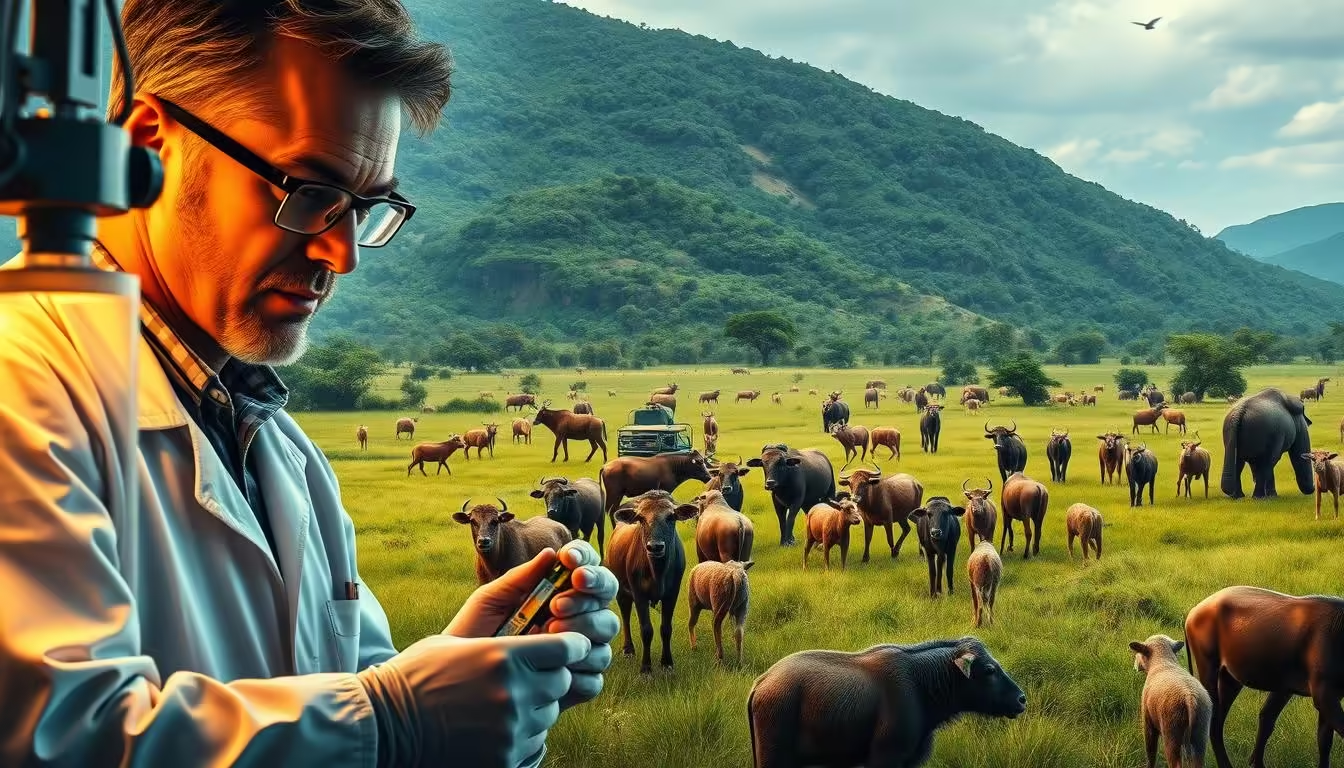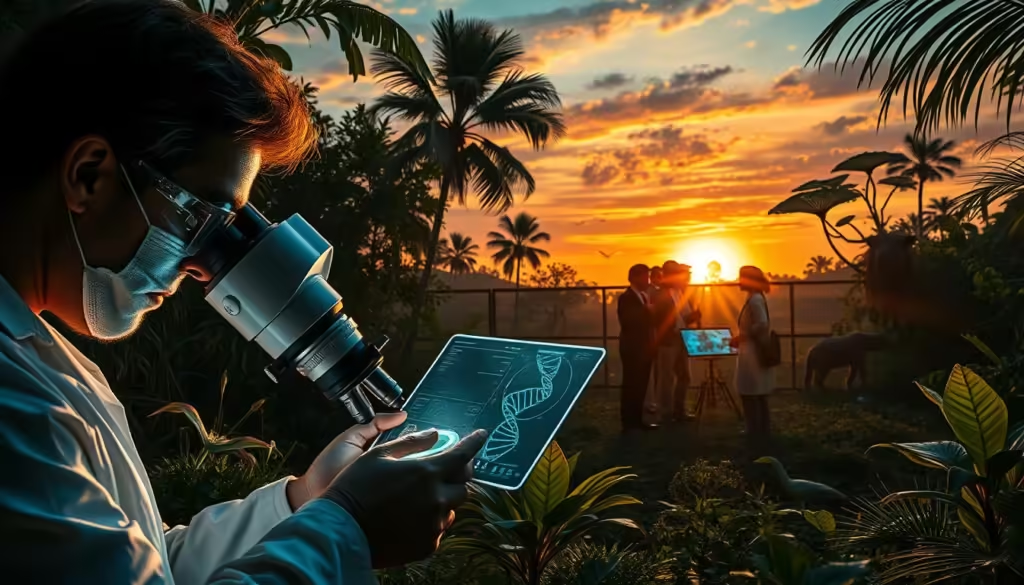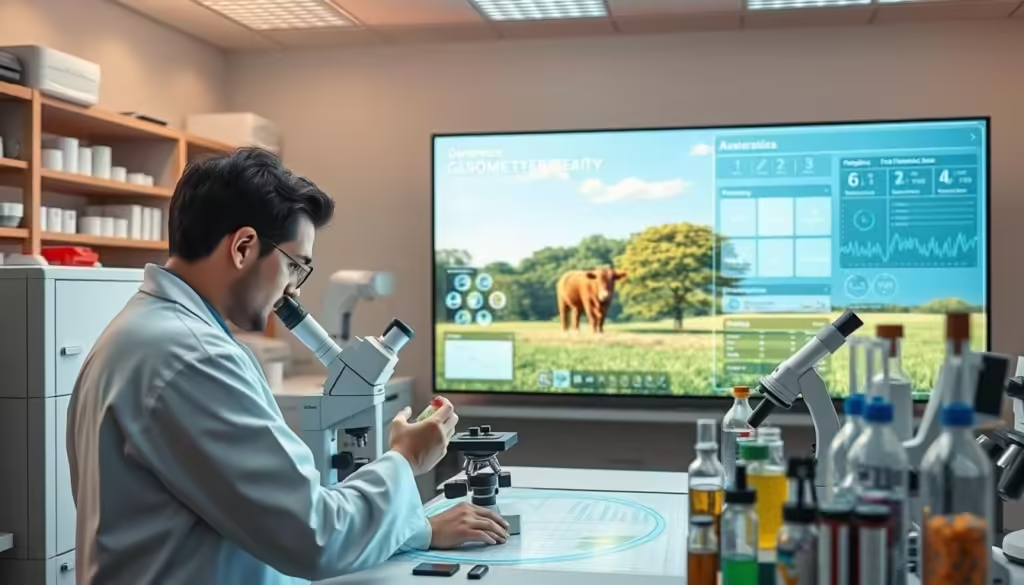DNA technology is revolutionizing the way we track and manage invasive species, helping to protect local ecosystems and preserve biodiversity. Invasive species can cause significant harm to native wildlife, altering habitats and disrupting delicate ecological balances.

The use of DNA technology allows for more accurate and efficient monitoring of invasive species, enabling conservationists to take targeted action to mitigate their impact. By analyzing DNA samples from the environment, researchers can identify the presence of invasive species and track their spread.
Key Takeaways
- DNA technology improves tracking of invasive species.
- Accurate monitoring enables targeted conservation efforts.
- Invasive species threaten native wildlife and ecosystems.
- DNA analysis helps identify and track invasive species.
- Conservationists can take action to mitigate the impact of invasive species.
The Growing Threat of Invasive Species
The threat of invasive species is escalating, with far-reaching consequences for environmental protection and ecosystem health. As the world becomes more interconnected, the risk of invasive species spreading to new territories increases, posing a significant challenge to conservation efforts.
Defining Invasive Species and Their Impact
Invasive species are non-native plants, animals, or microorganisms that outcompete native species for resources, alter habitats, and disrupt the delicate balance of ecosystems. Their impact can be devastating, leading to the loss of biodiversity, disruption of nutrient cycles, and even changes to the physical environment.

The Acceleration of Biological Invasions in the Modern Era
Human activities such as global trade, travel, and climate change have accelerated the spread of invasive species. As temperatures rise and ecosystems become more stressed, they become more vulnerable to invasion. Understanding the factors that contribute to biological invasions is crucial for developing effective strategies to mitigate their impact.
By recognizing the growing threat of invasive species and taking proactive measures, we can work towards protecting native ecosystems and preserving biodiversity.
Understanding the Ecological and Economic Toll
The invasive species issue has become a pressing concern due to its far-reaching ecological and economic impacts. Invasive species not only disrupt the natural balance of ecosystems but also impose significant financial burdens on the economy.
Disruption of Native Ecosystems
Invasive species can outcompete native species for resources, alter habitats, and disrupt the delicate balance of ecosystems. This can lead to a decline in biodiversity, as native species struggle to survive against the invaders. For instance, the introduction of non-native predators can decimate local wildlife populations, causing a ripple effect throughout the ecosystem.

Financial Costs of Invasive Species in the United States
The financial costs associated with invasive species are staggering. In the United States alone, invasive species cause an estimated $120 billion in economic losses annually. These costs are incurred through a variety of means, including damage to agriculture, forestry, and infrastructure, as well as the expenses associated with control and management efforts.
| Invasive Species | Economic Impact | Ecosystem Impact |
|---|---|---|
| Emerald Ash Borer | $10 billion in damages | Millions of ash trees killed |
| Asian Carp | $6.7 million in control efforts | Disruption of Great Lakes ecosystem |
Understanding these impacts is crucial for developing effective strategies to mitigate the effects of invasive species and protect both our ecosystems and our economy.
Traditional Methods of Tracking and Managing Invasives
For decades, managing invasive species has relied heavily on traditional methods. These approaches have been crucial in the initial stages of detection and management but come with their own set of challenges.
Physical Monitoring and Surveillance
Physical monitoring involves visually inspecting areas for signs of invasive species. This method is labor-intensive and requires trained personnel to identify species accurately. Surveillance often involves setting traps or conducting regular surveys in areas suspected of invasion.
| Method | Description | Effectiveness |
|---|---|---|
| Visual Inspection | Trained personnel visually inspect areas for invasive species. | Highly effective for visible species. |
| Trapping | Traps are set to capture and identify invasive species. | Effective for certain species, but can be labor-intensive. |
| Surveys | Regular surveys are conducted to monitor species presence. | Useful for early detection, but requires consistent effort. |
Limitations of Conventional Approaches
Despite their usefulness, traditional methods have significant limitations. They can be time-consuming, expensive, and often ineffective for detecting species at low densities. Moreover, these methods can be invasive themselves, potentially harming native ecosystems.
The limitations of traditional methods highlight the need for more efficient and less invasive techniques. As we move forward, it’s essential to consider these constraints when evaluating new approaches.

The DNA Revolution in Species Identification
The advent of DNA technology has revolutionized the field of species identification, offering unprecedented precision and insight. This molecular approach has transformed the way scientists track and manage invasive species, providing a more accurate and efficient means of identification.
From Microscopes to Molecules: A Paradigm Shift
The traditional method of species identification relied heavily on morphological characteristics, observed through microscopes. However, this approach had its limitations, often leading to misidentification. The shift to DNA analysis has marked a significant paradigm shift, enabling researchers to identify species at the molecular level. As noted by a leading researcher, “The use of DNA barcoding has been a game-changer in our ability to accurately identify species.”
“The use of DNA barcoding has been a game-changer in our ability to accurately identify species.”
How DNA Barcoding Works
DNA barcoding involves analyzing a specific segment of DNA to identify species. This process relies on the creation of a comprehensive genetic library, which serves as a reference point for comparison. By comparing the DNA sequence of an unknown sample to the library, researchers can accurately identify the species.

Building Genetic Libraries for Reference
The development of robust genetic libraries is crucial for the success of DNA barcoding. These libraries are constructed by collecting and analyzing DNA samples from known species, creating a comprehensive database for future reference. As the library grows, so does the accuracy of species identification.
In conclusion, the DNA revolution in species identification has transformed the field, offering a more precise and efficient means of tracking and managing invasive species. By leveraging DNA technology, researchers can now identify species with greater accuracy, paving the way for more effective conservation strategies.
Environmental DNA (eDNA): Detecting the Invisible
In the quest to protect native ecosystems, environmental DNA (eDNA) analysis has emerged as a powerful tool. This innovative approach allows scientists to detect the presence of invasive species without directly observing them, revolutionizing the field of conservation biology.
Collecting and Analyzing eDNA Samples
eDNA sampling involves collecting environmental samples such as water or soil, which may contain DNA shed by organisms. This DNA can then be analyzed to identify the species present in the environment. The process typically involves filtering the sample to capture the DNA, followed by laboratory analysis using techniques like PCR (Polymerase Chain Reaction) to amplify and identify the DNA sequences.

Early Detection Capabilities
One of the most significant advantages of eDNA analysis is its ability to detect invasive species at an early stage, often before they become established. This early detection capability is crucial for effective management and eradication efforts.
Aquatic Applications
In aquatic environments, eDNA sampling has proven particularly effective. For example, water samples can be used to detect the presence of invasive fish species or other aquatic organisms. This method has been successfully applied in various studies to monitor and manage invasive species in lakes, rivers, and coastal areas.
Terrestrial Applications
While more challenging than aquatic applications, eDNA sampling is also being explored for terrestrial environments. Soil samples, for instance, can be analyzed to detect the presence of invasive insects or plant species. This area of research is still developing but holds great promise for enhancing our ability to monitor and manage invasive species on land.
| Application | Sample Type | Detection Capability |
|---|---|---|
| Aquatic | Water | Highly effective for detecting invasive fish and other aquatic species |
| Terrestrial | Soil | Promising for detecting invasive insects and plants, still under development |
The use of eDNA technology represents a significant step forward in our ability to detect and manage invasive species. As research continues to advance in this field, we can expect to see more effective conservation strategies and better protection of native ecosystems.
Advanced Genomic Tools for Invasive Species Management
Advanced genomic technologies are revolutionizing the way we manage invasive species. These cutting-edge tools are providing unprecedented insights into the biology and ecology of invasive species, enabling more effective management strategies.
Next-Generation Sequencing Technologies
Next-generation sequencing (NGS) technologies have transformed the field of genomics, allowing for the rapid sequencing of large amounts of DNA. This capability is particularly valuable in the context of invasive species management, where it enables the identification of species and the monitoring of their spread with high precision.
For instance, NGS can be used to analyze environmental DNA (eDNA) samples, providing a non-invasive means of detecting the presence of invasive species. This approach has been successfully applied in various ecosystems, including aquatic and terrestrial environments.
| Technology | Application | Benefits |
|---|---|---|
| Next-Generation Sequencing | Species identification, eDNA analysis | High precision, rapid results |
| Metabarcoding | Biodiversity assessment, species monitoring | Comprehensive, cost-effective |
Metabarcoding and Metagenomics
Metabarcoding and metagenomics are related techniques that involve the analysis of DNA from mixed samples. Metabarcoding focuses on specific genetic markers to identify species within a sample, while metagenomics involves the analysis of all genetic material present.
“Metabarcoding has emerged as a powerful tool for assessing biodiversity and monitoring invasive species. Its ability to analyze complex samples makes it an invaluable asset in the fight against biological invasions.”
These approaches are particularly useful for understanding the complex interactions within ecosystems and for identifying the presence of invasive species.
CRISPR and Gene Editing Possibilities
The CRISPR-Cas9 gene editing system has opened up new possibilities for the management of invasive species. By enabling precise modifications to the genomes of target species, CRISPR technology holds the potential for controlling or even eradicating invasive populations.
CRISPR technology is still in its early stages of development for invasive species management, but it represents a promising avenue for future research and application.

Earth, Technology, and Sustainability: DNA Tech in Conservation
Conservation strategies are being transformed by the advent of DNA technology, offering new hope for sustainable ecosystems. As we continue to grapple with the challenges of invasive species and biodiversity loss, the integration of DNA tech into broader conservation strategies is proving to be a game-changer.
Integrating DNA Tech into Broader Conservation Strategies
The use of DNA technology allows for more precise and effective monitoring of ecosystems. By analyzing environmental DNA (eDNA), conservationists can detect the presence of invasive species early, preventing widespread invasion and damage.
“The application of DNA technology in conservation is a significant step forward in our ability to protect and preserve ecosystems.” – Dr. Jane Smith, Conservation Biologist.
| Conservation Strategy | Traditional Method | DNA Tech Method |
|---|---|---|
| Species Detection | Visual surveys | eDNA analysis |
| Monitoring | Physical trapping | Genetic sampling |
Creating Sustainable Management Solutions
DNA technology enables the development of targeted management plans. By understanding the genetic makeup of invasive species, conservationists can implement precision targeting, reducing the environmental impact of management efforts.
Reducing Environmental Impact Through Precision Targeting
Precision targeting through DNA tech minimizes the use of broad-spectrum chemicals and other invasive management techniques, thereby reducing environmental harm. This approach not only protects native species but also contributes to overall ecosystem health.
As we move forward, the integration of DNA technology into conservation practices will continue to enhance our ability to protect ecosystems sustainably. By embracing this technology, we can ensure a healthier planet for future generations.
Case Studies: DNA Technology Success Stories in American Ecosystems
The application of DNA technology in tracking and managing invasive species has shown remarkable success stories across various American ecosystems. This innovative approach has enabled scientists and conservationists to detect and manage invasive species more effectively, protecting native biodiversity and ecosystems.
Tracking Asian Carp in the Great Lakes
Asian carp, an invasive fish species, has been a significant threat to the Great Lakes ecosystem. DNA technology has been employed to track their presence and movement. By analyzing environmental DNA (eDNA) samples from water, researchers can detect the presence of Asian carp even at low densities.
Monitoring Burmese Pythons in the Everglades
Burmese pythons have invaded the Everglades, causing significant ecological damage. DNA technology, particularly eDNA analysis, has been used to monitor python populations. This approach allows for the detection of pythons in areas where they are difficult to survey using traditional methods.
Detecting Emerald Ash Borer Spread
The Emerald Ash Borer is an invasive beetle that has devastated ash tree populations across North America. DNA barcoding has been used to identify the beetle and monitor its spread. This information is crucial for developing effective management strategies to protect remaining ash trees.
Protecting Native Salmon from Invasive Species
Invasive species pose a significant threat to native salmon populations. DNA technology has been used to monitor the presence of invasive species in salmon habitats. By identifying potential threats early, conservationists can take proactive measures to protect native salmon.
| Case Study | DNA Technology Used | Outcome |
|---|---|---|
| Tracking Asian Carp | eDNA analysis | Effective detection of carp presence |
| Monitoring Burmese Pythons | eDNA analysis | Improved population monitoring |
| Detecting Emerald Ash Borer | DNA barcoding | Accurate identification and spread monitoring |
| Protecting Native Salmon | DNA monitoring | Early detection of invasive threats |
These case studies demonstrate the power of DNA technology in managing invasive species across different American ecosystems. By leveraging these innovative tools, we can enhance our conservation efforts and protect native biodiversity.
Citizen Science and Community Engagement in DNA Monitoring
DNA technology is becoming more accessible, thanks to citizen science and community engagement programs. These initiatives are crucial in enhancing our ability to monitor and manage invasive species across various ecosystems.
Democratizing DNA Technology
Citizen science projects empower individuals to contribute to DNA monitoring by collecting and analyzing environmental DNA (eDNA) samples. This not only aids in the detection of invasive species but also fosters a sense of community involvement in conservation efforts.
Successful Community-Based Monitoring Programs
Several community-based monitoring programs have shown significant success in utilizing DNA technology for invasive species detection. For instance, community-led eDNA sampling in water bodies has helped track the presence of invasive fish species.
| Program Name | Location | Target Species |
|---|---|---|
| RiverWatch | Great Lakes Region | Asian Carp |
| Wetland Guardians | Florida Everglades | Burmese Python |
Educational Opportunities and Public Awareness
These programs not only contribute to scientific research but also serve as educational tools, raising public awareness about the impact of invasive species and the importance of conservation. By engaging the public in DNA monitoring, we can build a more informed and active community.
Through citizen science and community engagement, DNA monitoring becomes a collaborative effort that benefits both the environment and the community. It’s a step towards a more inclusive and effective approach to managing invasive species.
Challenges and Future Directions in DNA-Based Monitoring
As DNA-based monitoring continues to evolve, it faces several challenges that need to be addressed. Despite its potential in tracking invasive species, there are technical, financial, and regulatory hurdles to overcome.
Technical Hurdles and Solutions
One of the primary technical challenges is the accuracy and reliability of DNA sampling and analysis. Improving the sensitivity of DNA detection methods is crucial for early detection of invasive species. Advances in next-generation sequencing technologies are helping to address these issues by providing more precise and comprehensive genetic data.
Cost Reduction and Accessibility Improvements
The cost of DNA-based monitoring technologies can be prohibitive for widespread adoption. Efforts to reduce costs and improve accessibility are underway, including the development of more affordable sequencing technologies and portable DNA analysis devices.
Integration with AI, Drones, and Automated Sampling
The future of DNA-based monitoring lies in its integration with other technologies such as AI, drones, and automated sampling systems. This integration can enhance the efficiency and effectiveness of monitoring programs, enabling real-time data collection and analysis.
Regulatory and Policy Frameworks
Effective DNA-based monitoring also requires robust regulatory and policy frameworks. These frameworks are essential for ensuring that DNA-based monitoring is used responsibly and that data is shared and utilized effectively across different jurisdictions.
By addressing these challenges and leveraging future opportunities, DNA-based monitoring can become an even more powerful tool in the fight against invasive species, protecting biodiversity and ecosystems.
Conclusion: Safeguarding Biodiversity Through Molecular Innovation
The threat of invasive species to local ecosystems and biodiversity is a pressing concern. DNA technology has emerged as a powerful tool in the fight against these invaders, offering a precise and efficient means of tracking and managing invasive species.
By leveraging molecular innovation, we can better safeguard ecosystems and preserve biodiversity. DNA barcoding, environmental DNA (eDNA) analysis, and advanced genomic tools have revolutionized the field, enabling early detection and targeted management of invasive species.
The integration of DNA technology into broader conservation strategies has shown promising results, from tracking Asian carp in the Great Lakes to monitoring Burmese pythons in the Everglades. As we move forward, it is essential to continue developing and refining these technologies, making them more accessible and cost-effective.
By harnessing the power of DNA technology and molecular innovation, we can protect native species, preserve ecosystem balance, and ensure the long-term health of our planet’s biodiversity. This cutting-edge approach holds great promise for safeguarding ecosystems and promoting a more sustainable future.
FAQ
What is DNA barcoding, and how does it help in tracking invasive species?
DNA barcoding is a genetic method used to identify species by analyzing a short DNA sequence. It helps track invasive species by enabling the identification of unknown DNA samples against a reference library of known species, thus aiding in the detection and monitoring of invasive species.
How does environmental DNA (eDNA) sampling work?
eDNA sampling involves collecting and analyzing DNA that is present in the environment, such as in water or soil, to detect the presence of specific species. This method is non-invasive and can be used to monitor species that are difficult to detect through traditional means.
What are the advantages of using DNA technology over traditional methods for managing invasive species?
DNA technology offers several advantages, including higher accuracy, the ability to detect species at early stages of invasion, and the capacity to monitor species in a non-invasive manner. It can also be more cost-effective and efficient than traditional methods.
Can citizen scientists contribute to DNA monitoring efforts?
Yes, citizen scientists can play a significant role in DNA monitoring by collecting samples and participating in community-based monitoring programs. This not only aids in the detection and management of invasive species but also enhances public awareness and education.
What are some of the challenges associated with DNA-based monitoring, and how are they being addressed?
Challenges include technical hurdles, cost, and accessibility. Solutions are being developed, such as improving DNA sequencing technologies, reducing costs, and integrating DNA monitoring with other technologies like AI and drones.
How can DNA technology be integrated with other conservation strategies?
DNA technology can be integrated into broader conservation strategies by combining it with traditional monitoring methods, using it to inform management decisions, and applying it in conjunction with other technologies to create more effective and sustainable management solutions.
What is the role of regulatory and policy frameworks in DNA-based monitoring?
Regulatory and policy frameworks are crucial for ensuring the effective use of DNA technology in managing invasive species. They provide guidelines for the application of DNA monitoring, help standardize methods, and facilitate the sharing of data across different jurisdictions.
Are there any successful examples of DNA technology being used to manage invasive species in the United States?
Yes, there are several examples, including tracking Asian carp in the Great Lakes, monitoring Burmese pythons in the Everglades, and detecting Emerald Ash Borer spread. These examples demonstrate the practical applications and successes of DNA technology in managing invasive species.








